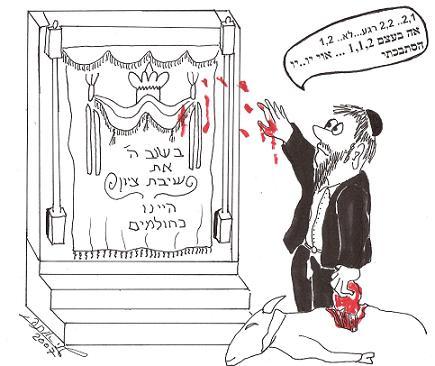
The Torah gave great detail about how the Yom Kippur ritual of atonement for Israel’s sins should be performed. One of the actions required for atonement is throwing the blood of the sacrifice upon the curtain in the Holy Temple seven times, for it is written “He shall take some of the blood of the bull and sprinkle it with his finger on the mercy seat on the east side, and before the mercy seat he shall sprinkle some of the blood with his finger seven times…So he shall make atonement for the Holy Place, because of the uncleanness of the children of Israel, and because of their transgressions, for all their sins” (Leviticus 16:14-16). The early sages ruled that the cohen who throws the blood on the curtain must make one throw upwards towards the curtain and seven more downwards toward the curtain. They also ruled that he must count aloud while throwing. But how, exactly, should he count? The sages disagreed. According to one sage, when the cohen makes his first upwards throw he should count “one.” With his subsequent downwards throws he should count “one and one,” “one and two,” “one and three,” “one and four,” “one and five,” “one and six,” “one and seven.” According to a different sage the count must be “one,” “one and one,” “two and one,” “three and one,” “four and one,” “five and one,” “six and one,” “seven and one.” Why did they disagree about the count? Answer: Each sage ruled that the count should be as was practiced in his area of residence. The sage who counted one, then two, was accustomed to saying numbers (like 21) by first giving the tens, then the single units — “twenty one.” The second sage lived where they first said the single units and then the tens: “one and twenty.” The scholars asked why the cohen had to mention, with each downward throw, the single upward throw as well. Answer: According to one sage, Rabbi Elazar, it was so the cohen did not get confused and forget that he had thrown upwards and so accidentally throw eight downward throws. A different sage, Rabbi Yochanan, learned from the Scriptural words “before the mercy seat he shall sprinkle” that the first throw upward must be mentioned during the count of each downward throw. The two answers represent two different schools of Halachic conclusions. According to the first explanation, “so that the cohen does not become confused,” if the cohen did not count the upward throw but did not get confused about the number of throws, they are valid and atone for the sins of the Jewish people. According to the second explanation which is learned by exegesis, “a Scriptural command with no explanation,” if the cohen did not make the count, even if he did not become confused, the throws are invalid and do not atone from the sins of the Jewish people.
(Babylonian Talmud, Tractate Yoma 55a)
